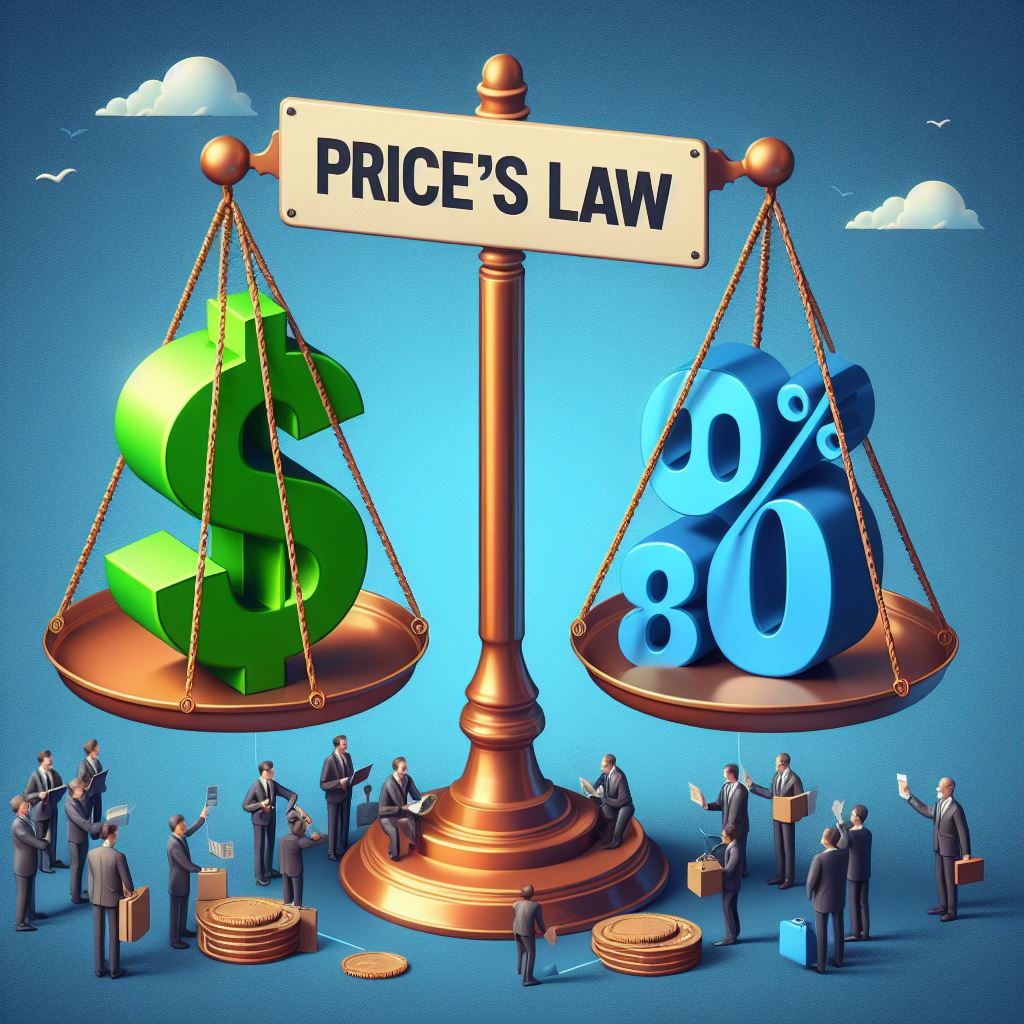Contents
- 1 Price’s Law and the 80/20 Rule are two concepts that describe the distribution of productivity and performance in various domains. Learn what they are, how they differ, and how they can help you optimize your business outcomes
- 2 Prof. Aécio D’Silva, Ph.D AquaUniversity
- 3 What is Price’s Law and how does it apply to business?
- 4 What is the 80/20 Rule and how does it apply to business?
- 5
- 6 How do Price’s Law and the 80/20 Rule differ?
- 7 How to use Price’s Law and the 80/20 Rule to optimize your business outcomes?
- 8 What are the benefits of using Price’s Law and the 80/20 Rule for your business?
- 9
- 10 What are the challenges and limitations of using Price’s Law and the 80/20 Rule for your business?
- 11 How to overcome the challenges and limitations, and use the power of Price’s Law and the 80/20 Rule for your business success?
- 12 Examples of Price’s law in action
Price’s Law and the 80/20 Rule are two concepts that describe the distribution of productivity and performance in various domains. Learn what they are, how they differ, and how they can help you optimize your business outcomes
Prof. Aécio D’Silva, Ph.D
AquaUniversity
Price’s Law and the 80/20 Rule are two principles that can help you understand and improve the productivity and performance of your business. They can help you identify and focus on the most important and impactful factors that drive your business results and eliminate or reduce the ones that waste time and resources.
What is Price’s Law and how does it apply to business?
Price’s Law, named after the British physicist Derek J. de Solla Price, who studied the scientific productivity of researchers, is a phenomenon that says that in many situations, the square root of the number of people in a domain does 50% of the work. For example, if there are 100 people in a company, 10 of them will produce 50% of the output, while the remaining 90 will produce the other 50%. The idea behind Price’s Law is that productivity and performance are not evenly distributed among people but rather follow a power law distribution, where a few people handle most of the work, and many people are responsible for little of the work.
Price’s Law can apply to business, as it can help you understand and improve the productivity and performance of your employees, teams, and departments. It can help you identify and use the most productive and valuable people in your organization and eliminate or reduce the ones that are less productive or valuable. It can also help you allocate the resources and responsibilities accordingly and provide the necessary support and feedback.
What is the 80/20 Rule and how does it apply to business?
The 80/20 Rule, also known as the Pareto Principle, named after the Italian economist Vilfredo Pareto, who observed that 80% of the land in Italy was owned by 20% of the population, is a phenomenon that states that in many situations, 80% of the effects come from 20% of the causes. For example, 80% of your sales may come from 20% of your customers, 80% of your complaints may come from 20% of your products, or 80% of your profits may come from 20% of your projects. The idea behind the 80/20 Rule is that effects and causes are not equally distributed, but rather follow a skewed distribution, where a few causes are responsible for most of the effects, and many causes are responsible for little of the effects.
The 80/20 Rule can apply to business, as it can help you understand and improve the productivity and performance of your products, services, and processes. It can help you identify and focus on the most important and impactful factors that contribute to your business results and eliminate or reduce the ones that are less important or impactful. It can also help you allocate the resources and time accordingly and provide the necessary support and feedback.
How do Price’s Law and the 80/20 Rule differ?
Price’s Law and the 80/20 Rule are two principles that describe the distribution of productivity and performance in various domains, but they differ in the following ways:
- Price’s Law applies to people, while the 80/20 Rule applies to factors. Price’s Law focuses on the productivity and performance of individuals or groups of people, while the 80/20 Rule focuses on the productivity and performance of products, services, or processes.
- Price’s Law uses a square root function, while the 80/20 Rule uses a ratio. Price’s Law states that the square root of the number of people in a domain do 50% of the work, while the 80/20 Rule states that 80% of the effects come from 20% of the causes. The square root function implies that as the number of people increases, the productivity and performance of the top performers decrease, while the ratio implies that as the number of factors increases, the productivity and performance of the top factors stay constant.
- Price’s Law is more specific, while the 80/20 Rule is more general. Price’s Law provides a precise formula to calculate the distribution of productivity and performance among people, while the 80/20 Rule provides a rough estimate to calculate the distribution of productivity and performance among factors. The 80/20 Rule can also vary depending on the situation, as sometimes the ratio can be 70/30, 90/10, or even 99/1.
How to use Price’s Law and the 80/20 Rule to optimize your business outcomes?
To use Price’s Law and the 80/20 Rule to optimize your business outcomes, you need to follow four steps: Analyze, Prioritize, Delegate, and Evaluate. These steps will help you to assess the current situation, identify the key factors that drive the most results, allocate the resources and responsibilities accordingly, and monitor the progress and outcomes.
- Analyze: The first step is to analyze your business data, such as your sales, profits, costs, quality, efficiency, satisfaction, and feedback. You can use various tools and methods to collect and visualize the data, such as surveys, interviews, reports, charts, and graphs. You should look for patterns and trends that reveal the distribution of the effects and the causes and try to find the Price’s Law and the 80/20 Rule in each aspect of your business.
- Prioritize: The second step is to prioritize the most important and impactful factors that contribute to your business outcomes, based on the analysis. You should focus on the square root of the number of people that do 50% of the work, and the 20% of the causes that generate 80% of the effects and rank them according to their value and urgency. You should also identify the remaining people and causes that do little of the work or generate little of the effects, and decide whether to eliminate, reduce, or improve them.
- Delegate: The third step is to delegate the tasks and responsibilities according to the priorities and allocate the resources and time accordingly. You should assign the most critical and valuable tasks to your best and most motivated employees and provide them with the necessary support and autonomy. You should also delegate the less important and less impactful tasks to your less skilled or less engaged employees and provide them with the necessary guidance and feedback. You should also assign the most important and impactful factors to your most productive and profitable products, services, or processes, and provide them with the necessary support and feedback. You should also delegate the less important and less impactful factors to your less productive or profitable products, services, or processes, and provide them with the necessary guidance and feedback.
- Evaluate: The fourth and last step is to evaluate the results and outcomes of your business, based on Price’s Law and the 80/20 Rule. You should measure and compare the output, quality, efficiency, satisfaction, and feedback of your employees, teams, departments, products, services, and processes before and after applying the principles, and look for improvements and gaps. You should also review and revise the priorities, tasks, and resources as needed, and celebrate and reward the achievements and progress.
What are the benefits of using Price’s Law and the 80/20 Rule for your business?
Using Price’s Law and the 80/20 Rule for your business can offer many benefits, such as:
- It can increase the productivity and efficiency of your business, as you can focus on the most important and impactful factors that drive your business results and avoid wasting time and resources on the less relevant and less effective ones.
- It can increase the satisfaction and motivation of your employees, as they can work on tasks that match their skills and interests and feel more valued and recognized for their contributions.
- It can increase the growth and development of your employees, as they can learn from the best practices and examples and acquire new skills and knowledge that can enhance their performance and career prospects.
- It can increase the innovation and creativity of your business, as you can explore new possibilities and solutions, and experiment with different approaches and methods.
- It can increase the profitability and sustainability of your business, as you can optimize your revenue and cost structure, and reduce your environmental and social impact.
What are the challenges and limitations of using Price’s Law and the 80/20 Rule for your business?
The 80/20 rule and Price’s law are two principles that can help you identify and prioritize the most impactful factors for your business. However, applying these principles can also pose some challenges and limitations such as:
- They can cause resistance from your employees, customers, or stakeholders who may not agree with your decisions or feel left out.
- They may also result in you missing some opportunities or innovations that are not captured by the 80/20 rule or Price’s law.
- They can be difficult and time-consuming to collect and analyze the data, and to find the correct and reliable Price’s Law and the 80/20 Rule in each aspect of your business.
- They can be subjective and biased to prioritize and rank the factors that affect your business outcomes and assign tasks and responsibilities accordingly.
- It can be risky and unpredictable to delegate and allocate resources and time based on Price’s Law and the 80/20 Rule, as it may not account for the changing and dynamic nature of the business environment and the customer needs and preferences.
- It can be ethically and legally problematic to use Price’s Law and the 80/20 Rule for your business, as it may create or reinforce inequalities and disparities among your employees, customers, and stakeholders, and affect their morale and well-being.
How to overcome the challenges and limitations, and use the power of Price’s Law and the 80/20 Rule for your business success?
Here are some tips:
- Communicate clearly and transparently with your team, customers, and partners about the rationale and benefits of applying these principles. Explain how they can help you achieve your goals and vision, and how they can also benefit from them.
- Involve your team, customers, and partners in the process of identifying and prioritizing the 20% of factors that matter most. Solicit their feedback, suggestions, and insights, and acknowledge their contributions.
- Balance the 80/20 rule and Price’s law with other criteria and methods that can complement and enhance your analysis. For example, you can use the PDCA Cycle, SWOT analysis, customer surveys, market research, or brainstorming sessions to generate innovative ideas and perspectives.
- Review and revise your 80/20 rule and Price’s law analysis regularly and adapt to changing circumstances. Be flexible and open to new information and opportunities that may arise.
By following these tips, you can overcome the challenges and limitations of using the 80/20 rule and Price’s law for your business and use their power to achieve your business success.
Examples of Price’s law in action
One example of Price’s law in action is the distribution of wealth in the world. According to the Global Wealth Report by Credit Suisse, 1.1% of the world’s population (56 million people) holds about 46% of the world’s total wealth. This means that the square root of the world’s population (about 8,000 people) owns almost half of the world’s wealth. This is a very extreme case of Price’s law, showing how a small elite dominates the global economy. [1]
Price’s Law states that a small number of employees, about 4 out of 16, contribute half of the work, while the remaining majority handle the other half. To illustrate, in a scenario where a business produces 2 million pens generating $500,000 in revenue, these four employees would account for $250,000 of revenue, with the other 12 employees contributing the same amount.
This principle becomes more pronounced in larger organizations. For instance, in a Marketing-as-a-Service firm with 225 salespeople, Price’s Law suggests that approximately 15 of them generate 50% of the sales, equating to $5 million out of a total of $10 million in sales. The remaining 210 salespeople are responsible for the other $5 million.
In larger corporations, the disparity is even more significant. In a company with 8,000 employees and $100 million in sales, approximately 90 employees generate $50 million in sales, while over 7,900 employees contribute to the remaining $50 million in revenue.
Price’s Law occurs organically and unintentionally in various contexts. It highlights the widening productivity gap between high performers and the rest as the size of the group increases. Essentially, it suggests that in the realm of business, as a company expands, competence tends to increase linearly, while incompetence tends to grow exponentially. As the organization grows, so does the number of individuals who fail to meet performance standards. [2]
These are just some examples of Price’s Law in action, but there are many more in different fields and domains. Price’s Law can help us understand how success and productivity are distributed among people, and how we can use it to our advantage.
In conclusion, Price’s Law and the 80/20 Rule are two different but related ways of describing the distribution of outcomes in various domains. Price’s Law focuses on the square root of the number of participants, while the 80/20 Rule focuses on the ratio of inputs and outputs. Both laws imply that a small fraction of the participants or inputs account for a large fraction of the outcomes or outputs. These laws can help us understand the patterns of success, productivity, and inequality in various fields and contexts. However, they are not deterministic or universal, and they do not imply causation or correlation. Therefore, we should use them as descriptive tools, not as prescriptive rules. We should also be aware of the limitations and assumptions of these laws and avoid oversimplifying or generalizing complex phenomena.
References:
[1] Global Wealth Report 2023. (2023). Credit Suisse and UBS. https://www.credit-suisse.com/about-us/en/reports-research/global-wealth-report.html
[2] Productivity and Price’s Law, Part 1. (2022). Monday Morning with Madison. https://mondaymornings.madisoncres.com/productivity-and-prices-law-1/






